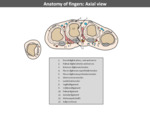Type:
Educational Exhibit
Keywords:
Musculoskeletal, Anatomy, Musculoskeletal soft tissue, Musculoskeletal system, CT, MR-Functional imaging, Ultrasound, Diagnostic procedure, Inflammation, Neoplasia, Tissue characterisation, Retrospective, Not applicable, Performed at one institution
Authors:
A. ANTÓN JIMÉNEZ1, M. T. Veintemillas1, I. Ramos Oliver1, R. SALGADO BARRIGA2, D. MORENO MARTINEZ3, M. De Albert de Delas Vigo1, A. Gimeno4, C. Torrents1, L. Casas1, R. Dominguez1; 1Barcelona/ES, 2BARCELONA, BA/ES, 3CORNELLA DE LLOBREGAT/ES, 4Barcelona, Barcelona/ES
DOI:
10.26044/ecr2020/C-14101
Background
Soft tissue lesions of fingers are commonly encountered in clinical practice and are often benign.[1]
Due to the anatomical complexity and different kind of constituents of fingers (tendons, muscles, vessels, nerve fibers, and adipose tissue) a wide spectrum of pathologic conditions can occur.[2] (Fig. 1, Fig. 2, Fig. 3)
Multiple imaging modality techniques are used to evaluate the location and nature of these lesions, offering complementary information.[1,4,5] (Fig. 4)
MR imaging is the gold standard technique for accurate tissue characterization of soft tissue lesions by noting features as signal characteristics and enhancement pattern and for determining its exact location and relation to surrounding structures.
Technical factors for MR imaging strategy include:[4]
- Position: Prone with elevated arm
- Specific surface coils
- Adequate sequences
MR characteristics and location can be used to favor a diagnosis, but the histological analysis is usually required to confirm it.[6] (Fig. 5, Fig. 6)
Functional and dynamic contrast-enhanced imaging, especially signal intensity-time curves, may improve the detection of malignancy since some benign lesions can be highly vascularized.[3] (Fig. 7)
Enhancement is also useful in selecting biopsy sites, avoiding necrotic areas and preparing the best path to evade dissemination.
MR findings help in therapeutic management and surgical planning, and local staging and prognosis for cases of a primary malignancy.







